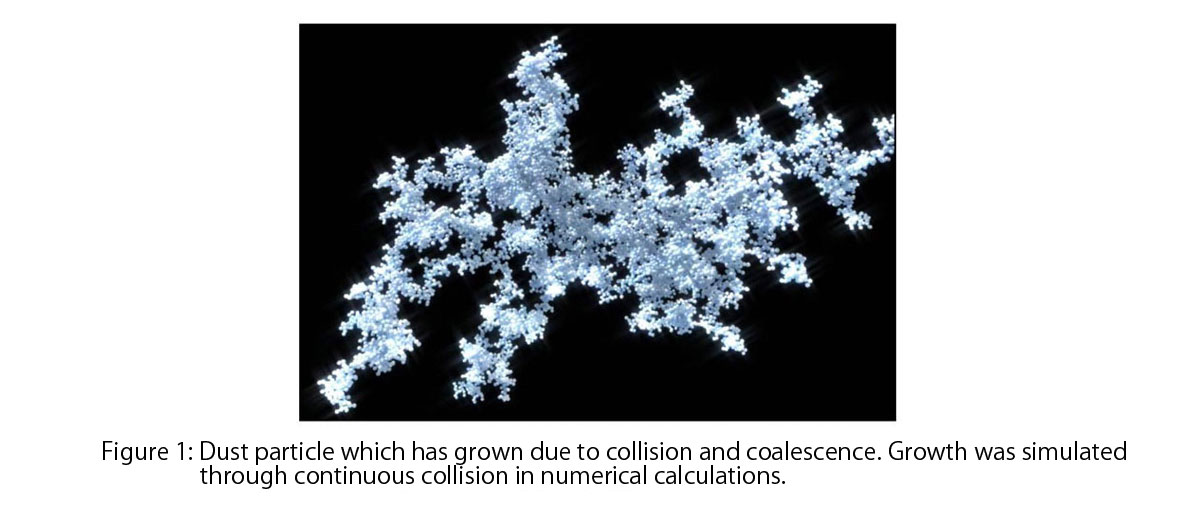Home > Researcher Columns > The Riddle of Planetesimals, the Seeds of Planets
The Riddle of Planetesimals, the Seeds of Planets
The planets of our solar system (including the earth) and the planets which orbit other stars are thought to have formed from the raw material of minute solid particles (dust) at most one micron in size and comprised of the rock and ice in the gaseous nebula surrounding a young star. In the standard theory of planet formation, the first stage is the formation of small celestial objects called planetesimals. These objects are about a kilometer in size and made of accumulated dust. Finally, it is thought that planets are formed due to repeated collision and coalescence of these planetesimals.
However, a number of serious issues remain concerning the process by which these planetesimals—which might be called the seeds of planets—are formed. The biggest difficulty is that objects smaller than a kilometer in size have extremely weak gravity, and it is difficult to make them coalesce. Accretion to a planetesimal due to this weak gravity is impeded even by the slight winds present in a gaseous nebula. In addition, the problem of gas drag has also been raised, i.e., when dust accumulations have grown to meter-size, they experience strong gas drag due to the nebular gas, and fall into the star.
In our group, we have tried to elucidate the riddle of planetesimal formation by carrying out computer simulations of the process whereby cosmic dust particles collide and coalesce. We are studying how easily dust particles stick together, and what sort of internal structure they have. When we start from micron size particles, and they grow through repeated coalescence, an aggregate of particles is formed (Fig. 1). This results in the appearance of the cosmic dust present at the initial stage of planet formation. The reason why this sort of dust sticks together is not gravity, but rather the chemical bonding force which acts between the molecules making up the particle.
The computer simulations of dust coalescence and growth we have carried out have shown that dust evolves into a structure with an extremely large amount of empty space. Previously, it was thought that empty spaces would be easily compressed due to the force of collision, but we have found that compression does not progress very far.

Based on our computer simulation, it was shown that dust with a large amount of empty space sticks together extremely easily. If the collision speed between dust particles is sufficiently high, the particles do not coalesce and instead are broken into small pieces. The maximum collision speed where dust can coalesce was investigated through computer simulation, and the results were surprising. Dust particles comprised of ice could coalesce without breaking provide the collision speed was at or below 200 km/hour. Even in the case of dust comprised mainly of rock, the same results are obtained when the outsides of the particles are covered with ice. One reason for this result—i.e., that sticking can occur even with high-speed collisions—is the dust's structure with a large amount of empty space. Due to this structure, it is possible to smoothly absorb the shock when a collision occurs. Another important factor is the fact that dust is comprised of extremely small micron-size particles. If dust is made of small particles, the total area of contact between individual particles increases. This results in higher bond energy of all particles, and makes the structure difficult to break.

Because dust can easily stick together in this way, we are advocating the theory that planetesimals are formed only though growth via sticking, and the process is not aided by gravity. Since growth proceeds by sticking, the weakness of gravity presents no problem. In addition, adhesion growth of dust occurs quickly when the dust is enlarged due to the large amount of empty space, and thus the effect whereby dust falls into the star is not a problem. In this way, the adhesion growth theory allows us to smoothly resolve a point previously regarded as an issue.
Our next topic will be to use astronomical observations to verify the adhesion growth theory of planetesimal formation which we have proposed. Therefore, we are currently moving forward with a plan of directly confirming dust structured with a large amount of empty space during the growth process. This will be done by using infrared and radio telescopes to observe the gaseous nebulae around the young stars which are the site of planet formation. How can dust enlarged due to a large amount of empty space be seen with a telescope? To confirm such dust, what telescope should be used for observation, and how should it be used? While resolving these each of these issues in turn, we are moving toward elucidation of whether dust containing large amounts of empty space is actually present at the sites of planet formation.
Hidekazu Tanaka (Hokkaido University)
